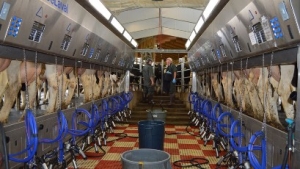Dairy in the World
UK dairy profits expected to recover in 2020, says Old Mill

The report - conducted by rural accountant Old Mill and the Farm Consultancy Group - found that dairy farm profits averaged £233/cow in the year to 31 March 2020 - up from £141 the previous year. However, there remained a big gap between the top and bottom producers, with the top 10 percent averaging a profit of 12p/litre compared with a loss of 5.48p/litre for the bottom 10 percent, with 24 percent of the sample not breaking even.
“This is a big reason why 2.5 percent of producers are ceasing production annually,” explains Gerard Finnan, farm business consultant at the Farm Consultancy Group. “At the current rate, a lot of the bottom 10 percent could be gone in four-to-five years’ time, unless they change their management decisions.”
This is the third year in a row that income has remained stable, with both yields and prices seeing little change on the previous season. Though the average milk price remained around 31p/litre, the subsequent challenges presented by COVID-19 meant a number of milk buyers instructed suppliers to cut production or dispose of milk. “This resulted in some producers capitulating, and though the distressed milk market is now behind us, the report highlights how finely balanced supply and demand is,” explains Dan Heal, rural accountant at Old Mill.
The top 10 percent of producers have once again outperformed the bottom 10 percent by over £1,000/cow, despite income levels only being £142/cow higher. Reducing costs has been a major driver for numerous producers over the past year, with producers cutting costs by an average of £124/cow, explains Mr Finnan.
However, the effectiveness and impact of cutting costs is starkly apparent between the top and bottom 10 percent of producers. “Cost efficiency is about much more than requesting suppliers to reduce their prices,” says Mr Heal. “It is looking into the expenditure of the business and adapting to suit the farm or milk contract. Or making timely investments if they will give a return.”
After the drought during the 2018/19 season, the favourable growing conditions of 2019 resulted in a £97/cow drop in purchased feed costs, says Mr Heal. Producers also spent less on seeds, fertilisers and sprays, with the weather allowing for the production of large quantities of quality forage. “However, the unpredictability of the weather does mean it is an aspect that is much harder to plan for.”
In contrast, machinery costs rose by 10 percent on the year, due to increased contracting costs, with a corresponding fall in depreciation as field operations are increasingly outsourced, explains Mr Heal. The top 10 percent spent £342/cow less on power and machinery than the bottom 10 percent, whose costs averaged £710/cow.
It’s notable that yields, herd size and system are not driving profits. Yield per cow in the top 10 percent by profit ranged from 4,520 litres, to 10,393 litres, while in the bottom 10 percent it varied from 3,974 litres to 8,614 litres.
Though the top 10 percent of producers have double the herd size of the bottom, scale should not affect variable costs, explains Mr Finnan. Variable costs were 4.5p/litre cheaper for the top 10 percent, and though greater buying power might account for 1p/litre, it shouldn’t account for 4.5 times that, he adds.
Again, system has little impact on the profitability of a business. Of the top 10 percent in terms of profitability, 44 percent were spring calving, 28 percent were autumn calving and 28 percent all-year-round, with organic and non-organic enterprises represented across these. “The same applies in the bottom 10 percent,” says Mr Finnan. “Profitability is not down to what you do, it is the way you do it.”
Projections
Budgeted profits for 2020/21 - based on an increase in milk output of 186 litres/cow, stable cow numbers, a 0.5p/litre fall in milk price and consistent costs of production – are predicted to remain similar to 2019/2020.
Despite this anticipated stability, the report demonstrates that buyer security is volatile in times of oversupply and cost control is more effective when looking at the business as a whole. “It is not possible to control everything, but the most successful farmers adapt what they can control to suit the factors they can’t,” says Mr Heal.
“Most of the above points are within a farmer’s control if they need or wish to improve business profits,” adds Mr Finnan. “Benchmark in detail against the best and focus on three-to-four key costs. Develop an action plan to reduce these costs and get the whole farm team to buy into what you are trying to achieve.”
Survey basis:
-
The sample consists of Old Mill and Farm Consultancy Group clients who derive their income mainly or solely from milk sales, across a variety of farming systems.
-
All farms have a 31 March year-end.
-
In order to make the businesses comparable, rents, interest payments, drawings, tax and capital expenditure have been excluded from the figures and a labour charge of £30,000 has been included per full-time partner/director. Basic Payment Scheme income has also been excluded. Depreciation has been included in these figures.
-
The projection for 2021 has been calculated by looking at actual costs incurred for this financial year to date along with national trends.























